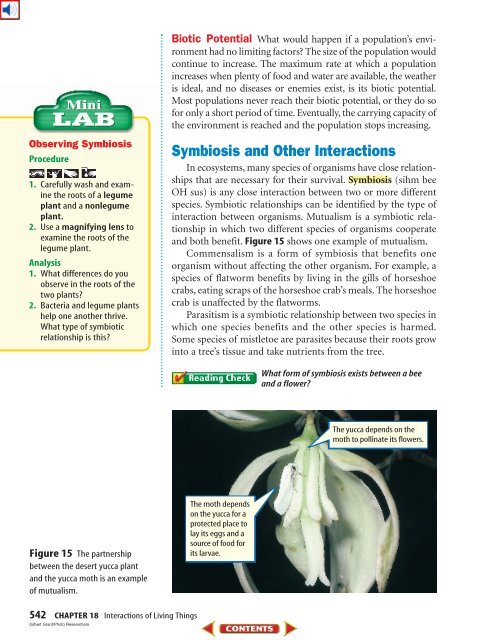Chapter 18: Interactions of Living Things
Chapter 18: Interactions of Living Things
Chapter 18: Interactions of Living Things
You also want an ePaper? Increase the reach of your titles
YUMPU automatically turns print PDFs into web optimized ePapers that Google loves.
Observing Symbiosis<br />
Procedure<br />
1. Carefully wash and examine<br />
the roots <strong>of</strong> a legume<br />
plant and a nonlegume<br />
plant.<br />
2. Use a magnifying lens to<br />
examine the roots <strong>of</strong> the<br />
legume plant.<br />
Analysis<br />
1. What differences do you<br />
observe in the roots <strong>of</strong> the<br />
two plants?<br />
2. Bacteria and legume plants<br />
help one another thrive.<br />
What type <strong>of</strong> symbiotic<br />
relationship is this?<br />
Figure 15 The partnership<br />
between the desert yucca plant<br />
and the yucca moth is an example<br />
<strong>of</strong> mutualism.<br />
542 CHAPTER <strong>18</strong> <strong>Interactions</strong> <strong>of</strong> <strong>Living</strong> <strong>Things</strong><br />
Gilbert Grant/Photo Researchers<br />
Biotic Potential What would happen if a population’s environment<br />
had no limiting factors? The size <strong>of</strong> the population would<br />
continue to increase. The maximum rate at which a population<br />
increases when plenty <strong>of</strong> food and water are available, the weather<br />
is ideal, and no diseases or enemies exist, is its biotic potential.<br />
Most populations never reach their biotic potential, or they do so<br />
for only a short period <strong>of</strong> time. Eventually, the carrying capacity <strong>of</strong><br />
the environment is reached and the population stops increasing.<br />
Symbiosis and Other <strong>Interactions</strong><br />
In ecosystems, many species <strong>of</strong> organisms have close relationships<br />
that are necessary for their survival. Symbiosis (sihm bee<br />
OH sus) is any close interaction between two or more different<br />
species. Symbiotic relationships can be identified by the type <strong>of</strong><br />
interaction between organisms. Mutualism is a symbiotic relationship<br />
in which two different species <strong>of</strong> organisms cooperate<br />
and both benefit. Figure 15 shows one example <strong>of</strong> mutualism.<br />
Commensalism is a form <strong>of</strong> symbiosis that benefits one<br />
organism without affecting the other organism. For example, a<br />
species <strong>of</strong> flatworm benefits by living in the gills <strong>of</strong> horseshoe<br />
crabs, eating scraps <strong>of</strong> the horseshoe crab’s meals. The horseshoe<br />
crab is unaffected by the flatworms.<br />
Parasitism is a symbiotic relationship between two species in<br />
which one species benefits and the other species is harmed.<br />
Some species <strong>of</strong> mistletoe are parasites because their roots grow<br />
into a tree’s tissue and take nutrients from the tree.<br />
The moth depends<br />
on the yucca for a<br />
protected place to<br />
lay its eggs and a<br />
source <strong>of</strong> food for<br />
its larvae.<br />
What form <strong>of</strong> symbiosis exists between a bee<br />
and a flower?<br />
The yucca depends on the<br />
moth to pollinate its flowers.

















